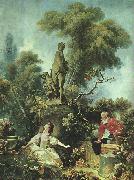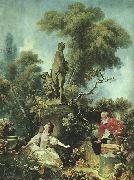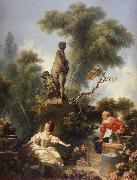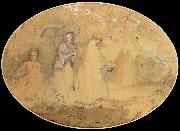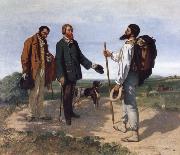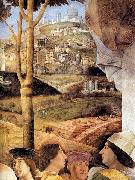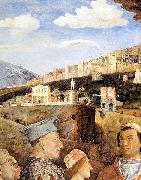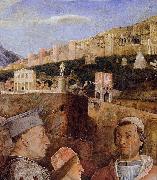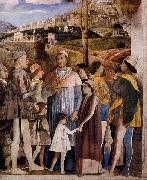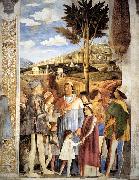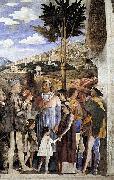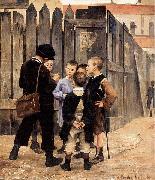Wholesale Oil Painting No Minimum |
|||||||||||
|
|
|||||||||||

|
|||||||||||
|
|
|
||||||||
Jean Honore Fragonard1732-1806 French Jean Honore Fragonard Locations French painter. He studied with François Boucher in Paris c. 1749. He subsequently won a Prix de Rome, and while in Italy (1756 ?C 61) he traveled extensively and executed many sketches of the countryside, especially the gardens at the Villa d Este at Tivoli, and developed a great admiration for the work of Giovanni Battista Tiepolo. In 1765 his large historical painting Coresus Sacrifices Himself to Save Callirhoë was purchased for Louis XV and won Fragonard election to the French Royal Academy. He soon abandoned this style to concentrate on landscapes in the manner of Jacob van Ruisdael, portraits, and the decorative, erotic outdoor party scenes for which he became famous (e.g., The Swing, c. 1766). The gentle hedonism of such party scenes epitomized the Rococo style. Although the greater part of his active life was passed during the Neoclassical period, he continued to paint in a Rococo idiom until shortly before the French Revolution, when he lost his patrons and livelihood. |
||||||||
|
|
||||||||
The Meeting
The Meeting Painting ID:: 1259 |
1771-73
Frick Collection, New York 1771-73 Frick Collection, New York |
|||||||
|
|
||||||||
Jean-Honore FragonardFrench Rococo Era Painter, 1732-1806 was a French painter and printmaker whose late Rococo manner was distinguished by remarkable facility, exuberance, and hedonism. One of the most prolific artists active in the last decades of the Ancien Regime, Fragonard produced more than 550 paintings , of which only five are dated. Among his most popular works are genre paintings conveying an atmosphere of intimacy and veiled eroticism. He was born at Grasse, Alpes-Maritimes, the son of François Fragonard, a glover, and Françoise Petit. He was articled to a Paris notary when his father's circumstances became strained through unsuccessful speculations, but showed such talent and inclination for art that he was taken at the age of eighteen to François Boucher, who, recognizing the youth's rare gifts but disinclined to waste his time with one so inexperienced, sent him to Chardin's atelier. Fragonard studied for six months under the great luminist, then returned more fully equipped to Boucher, whose style he soon acquired so completely that the master entrusted him with the execution of replicas of his paintings. Though not yet a pupil of the Academy, Fragonard gained the Prix de Rome in 1752 with a painting of "Jeroboam Sacrificing to the Golden Calf", but before proceeding to Rome he continued to study for three years under Charles-Andre van Loo. In the year preceding his departure he painted the "Christ washing the Feet of the Apostles" now at Grasse cathedral. On September 17, 1756, he took up his abode at the French Academy in Rome, then presided over by Charles-Joseph Natoire. While at Rome, Fragonard contracted a friendship with a fellow painter, Hubert Robert. In 1760, they toured Italy together, executing numerous sketches of local scenery. It was in these romantic gardens, with their fountains, grottos, temples and terraces, that Fragonard conceived the dreams which he was subsequently to render in his art. He also learned to admire the masters of the Dutch and Flemish schools (Rubens, Hals, Rembrandt, Ruisdael), imitating their loose and vigorous brushstrokes. Added to this influence was the deep impression made upon his mind by the florid sumptuousness of Giovanni Battista Tiepolo, whose works he had an opportunity to study in Venice before he returned to Paris in 1761. In 1765 his "Coresus et Callirhoe" secured his admission to the Academy. It was made the subject of a pompous (though not wholly serious) eulogy by Diderot, and was bought by the king, who had it reproduced at the Gobelins factory. Hitherto Fragonard had hesitated between religious, classic and other subjects; but now the demand of the wealthy art patrons of Louis XV's pleasure-loving and licentious court turned him definitely towards those scenes of love and voluptuousness with which his name will ever be associated, and which are only made acceptable by the tender beauty of his color and the virtuosity of his facile brushwork; |
||||||||
|
|
||||||||
|
|
The Meeting
The Meeting Painting ID:: 10311 |
771-73, Frick
Collection NY 771-73, Frick Collection NY |
||||||
|
|
||||||||
Jean-Honore FragonardFrench Rococo Era Painter, 1732-1806 was a French painter and printmaker whose late Rococo manner was distinguished by remarkable facility, exuberance, and hedonism. One of the most prolific artists active in the last decades of the Ancien Regime, Fragonard produced more than 550 paintings , of which only five are dated. Among his most popular works are genre paintings conveying an atmosphere of intimacy and veiled eroticism. He was born at Grasse, Alpes-Maritimes, the son of François Fragonard, a glover, and Françoise Petit. He was articled to a Paris notary when his father's circumstances became strained through unsuccessful speculations, but showed such talent and inclination for art that he was taken at the age of eighteen to François Boucher, who, recognizing the youth's rare gifts but disinclined to waste his time with one so inexperienced, sent him to Chardin's atelier. Fragonard studied for six months under the great luminist, then returned more fully equipped to Boucher, whose style he soon acquired so completely that the master entrusted him with the execution of replicas of his paintings. Though not yet a pupil of the Academy, Fragonard gained the Prix de Rome in 1752 with a painting of "Jeroboam Sacrificing to the Golden Calf", but before proceeding to Rome he continued to study for three years under Charles-Andre van Loo. In the year preceding his departure he painted the "Christ washing the Feet of the Apostles" now at Grasse cathedral. On September 17, 1756, he took up his abode at the French Academy in Rome, then presided over by Charles-Joseph Natoire. While at Rome, Fragonard contracted a friendship with a fellow painter, Hubert Robert. In 1760, they toured Italy together, executing numerous sketches of local scenery. It was in these romantic gardens, with their fountains, grottos, temples and terraces, that Fragonard conceived the dreams which he was subsequently to render in his art. He also learned to admire the masters of the Dutch and Flemish schools (Rubens, Hals, Rembrandt, Ruisdael), imitating their loose and vigorous brushstrokes. Added to this influence was the deep impression made upon his mind by the florid sumptuousness of Giovanni Battista Tiepolo, whose works he had an opportunity to study in Venice before he returned to Paris in 1761. In 1765 his "Coresus et Callirhoe" secured his admission to the Academy. It was made the subject of a pompous (though not wholly serious) eulogy by Diderot, and was bought by the king, who had it reproduced at the Gobelins factory. Hitherto Fragonard had hesitated between religious, classic and other subjects; but now the demand of the wealthy art patrons of Louis XV's pleasure-loving and licentious court turned him definitely towards those scenes of love and voluptuousness with which his name will ever be associated, and which are only made acceptable by the tender beauty of his color and the virtuosity of his facile brushwork; |
||||||||
|
|
||||||||
|
|
The Meeting
The Meeting Painting ID:: 31803 |
mk76
Painted in 1771-73
Oil on canvas
mk76 Painted in 1771-73 Oil on canvas |
||||||
|
|
||||||||
Charles conderEnglish-born Australian Painter, 1868-1909 English painter, active in Australia and France. He was sent to Australia in 1884 to learn surveying under his uncle W. J. Conder. After about two years in survey camps, he attended evening classes at the Royal Art Society, Sydney; in 1887 he worked as a lithographic draughtsman for the Illustrated Sydney News. Tom Roberts, then in Sydney on a visit from Melbourne, was among the open-air landscape painters that he knew at this time. He taught Conder some of the principles of Impressionism, such as truth to the momentary effect of light and to colour values, and the rejection of the academic ideal of high finish. The most important painting of Conder's Sydney years, the Departure of the 'SS Orient' from Circular Quay, 1888 (1888; Sydney, A.G. NSW), already showed a distinct personal style, combining humour with nostalgia and selective observation with decorative finesse of handling and design. In December 1888 Conder joined Roberts and Arthur Streeton in Melbourne. During the following summers they painted together at the outer suburbs of Mentone, Box Hill and Eaglemont |
||||||||
|
|
||||||||
|
|
The Meeting
The Meeting Painting ID:: 42159 |
mk167
c.1895
Watercolo on silk
mk167 c.1895 Watercolo on silk |
||||||
|
|
||||||||
Gustave Courbet1819-1877 French Gustave Courbet Locations was a French painter whose powerful pictures of peasants and scenes of everyday life established him as the leading figure of the realist movement of the mid-19th century. Gustave Courbet was born at Ornans on June 10, 1819. He appears to have inherited his vigorous temperament from his father, a landowner and prominent personality in the Franche-Comte region. At the age of 18 Gustave went to the College Royal at Besancon. There he openly expressed his dissatisfaction with the traditional classical subjects he was obliged to study, going so far as to lead a revolt among the students. In 1838 he was enrolled as an externe and could simultaneously attend the classes of Charles Flajoulot, director of the ecole des Beaux-Arts. At the college in Besançon, Courbet became fast friends with Max Buchon, whose Essais Poetiques (1839) he illustrated with four lithographs. In 1840 Courbet went to Paris to study law, but he decided to become a painter and spent much time copying in the Louvre. In 1844 his Self-Portrait with Black Dog was exhibited at the Salon. The following year he submitted five pictures; only one, Le Guitarrero, was accepted. After a complete rejection in 1847, the Liberal Jury of 1848 accepted all 10 of his entries, and the critic Champfleury, who was to become Courbet first staunch apologist, highly praised the Walpurgis Night. |
||||||||
|
|
||||||||
|
|
The Meeting
The Meeting Painting ID:: 55243 |
mk240
1854
Oil on canvas
129x149cm
mk240 1854 Oil on canvas 129x149cm |
||||||
|
|
||||||||
Andrea MantegnaItalian 1431-1506 Andrea Mantegna Locations Mantegna was born in Isola di Carturo, close to Padua in the Republic of Venice, second son of a carpenter, Biagio. At the age of eleven he became the apprentice of Francesco Squarcione, Paduan painter. Squarcione, whose original vocation was tailoring, appears to have had a remarkable enthusiasm for ancient art, and a faculty for acting. Like his famous compatriot Petrarca, Squarcione was something of a fanatic for ancient Rome: he travelled in Italy, and perhaps Greece, amassing antique statues, reliefs, vases, etc., forming a collection of such works, then making drawings from them himself, and throwing open his stores for others to study. All the while, he continued undertaking works on commission for which his pupils no less than himself were made available. San Zeno Altarpiece, (left panel), 1457-60; San Zeno, VeronaAs many as 137 painters and pictorial students passed through Squarcine's school, which had been established towards 1440 and which became famous all over Italy. Padua was attractive for artists coming not only from Veneto but also from Tuscany, such as Paolo Uccello, Filippo Lippi and Donatello. Mantegna's early career was shaped indeed by impressions of Florentine works. At the time, Mantegna was said to be a favorite pupil; Squarcione taught him the Latin language, and instructed him to study fragments of Roman sculpture. The master also preferred forced perspective, the lingering results of which may account for some Mantegna's later innovations. However, at the age of seventeen, Mantegna separated himself from Squarcione. He later claimed that Squarcione had profited from his work without paying the rights. His first work, now lost, was an altarpiece for the church of Santa Sofia in 1448. The same year Mantegna was called, together with Nicol?? Pizolo, to work with a large group of painters entrusted with the decoration of the Ovetari Chapel in the apse of the church of Eremitani. It is probable, however, that before this time some of the pupils of Squarcione, including Mantegna, had already begun the series of frescoes in the chapel of S. Cristoforo, in the church of Sant'Agostino degli Eremitani, today considered his masterpiece. After a series of coincidences, Mantegna finished most of the work alone, though Ansuino, who collaborated with Mantegna in the Ovetari Chapel, brought his style in the Forl?? school of painting. The now censorious Squarcione carped about the earlier works of this series, illustrating the life of St James; he said the figures were like men of stone, and had better have been colored stone-color at once. This series was almost entirely lost in the 1944 Allied bombings of Padua. The most dramatic work of the fresco cycle was the work set in the worm's-eye view perspective, St. James Led to His Execution. (For an example of Mantegna's use of a lowered view point, see the image at right of Saints Peter and Paul; though much less dramatic in its perspective that the St. James picture, the San Zeno altarpiece was done shortly after the St. James cycle was finished, and uses many of the same techniques, including the classicizing architectural structure.) San Luca Altarpiece, 1453; Tempera on panel; Pinacoteca di Brera, MilanThe sketch of the St. Stephen fresco survived and is the earliest known preliminary sketch which still exists to compare to the corresponding fresco. Despite the authentic look of the monument, it is not a copy of any known Roman structure. Mantegna also adopted the wet drapery patterns of the Romans, who derived the form from the Greek invention, for the clothing of his figures, although the tense figures and interactions are derived from Donatello. The drawing shows proof that nude figures were used in the conception of works during the Early Renaissance. In the preliminary sketch, the perspective is less developed and closer to a more average viewpoint however. Among the other early Mantegna frescoes are the two saints over the entrance porch of the church of Sant'Antonio in Padua, 1452, and an altarpiece of St. Luke and other saints (at left) for the church of S. Giustina, now in the Brera Gallery in Milan (1453). As the young artist progressed in his work, he came under the influence of Jacopo Bellini, father of the celebrated painters Giovanni and Gentile, and of a daughter Nicolosia. In 1453 Jacopo consented to a marriage between Nicolosia to Mantegna in marriage. |
||||||||
|
|
||||||||
|
|
The Meeting
The Meeting Painting ID:: 87995 |
between 1465(1465) and 1474
cyf between 1465(1465) and 1474 cyf |
||||||
|
|
||||||||
Andrea MantegnaItalian 1431-1506 Andrea Mantegna Locations Mantegna was born in Isola di Carturo, close to Padua in the Republic of Venice, second son of a carpenter, Biagio. At the age of eleven he became the apprentice of Francesco Squarcione, Paduan painter. Squarcione, whose original vocation was tailoring, appears to have had a remarkable enthusiasm for ancient art, and a faculty for acting. Like his famous compatriot Petrarca, Squarcione was something of a fanatic for ancient Rome: he travelled in Italy, and perhaps Greece, amassing antique statues, reliefs, vases, etc., forming a collection of such works, then making drawings from them himself, and throwing open his stores for others to study. All the while, he continued undertaking works on commission for which his pupils no less than himself were made available. San Zeno Altarpiece, (left panel), 1457-60; San Zeno, VeronaAs many as 137 painters and pictorial students passed through Squarcine's school, which had been established towards 1440 and which became famous all over Italy. Padua was attractive for artists coming not only from Veneto but also from Tuscany, such as Paolo Uccello, Filippo Lippi and Donatello. Mantegna's early career was shaped indeed by impressions of Florentine works. At the time, Mantegna was said to be a favorite pupil; Squarcione taught him the Latin language, and instructed him to study fragments of Roman sculpture. The master also preferred forced perspective, the lingering results of which may account for some Mantegna's later innovations. However, at the age of seventeen, Mantegna separated himself from Squarcione. He later claimed that Squarcione had profited from his work without paying the rights. His first work, now lost, was an altarpiece for the church of Santa Sofia in 1448. The same year Mantegna was called, together with Nicol?? Pizolo, to work with a large group of painters entrusted with the decoration of the Ovetari Chapel in the apse of the church of Eremitani. It is probable, however, that before this time some of the pupils of Squarcione, including Mantegna, had already begun the series of frescoes in the chapel of S. Cristoforo, in the church of Sant'Agostino degli Eremitani, today considered his masterpiece. After a series of coincidences, Mantegna finished most of the work alone, though Ansuino, who collaborated with Mantegna in the Ovetari Chapel, brought his style in the Forl?? school of painting. The now censorious Squarcione carped about the earlier works of this series, illustrating the life of St James; he said the figures were like men of stone, and had better have been colored stone-color at once. This series was almost entirely lost in the 1944 Allied bombings of Padua. The most dramatic work of the fresco cycle was the work set in the worm's-eye view perspective, St. James Led to His Execution. (For an example of Mantegna's use of a lowered view point, see the image at right of Saints Peter and Paul; though much less dramatic in its perspective that the St. James picture, the San Zeno altarpiece was done shortly after the St. James cycle was finished, and uses many of the same techniques, including the classicizing architectural structure.) San Luca Altarpiece, 1453; Tempera on panel; Pinacoteca di Brera, MilanThe sketch of the St. Stephen fresco survived and is the earliest known preliminary sketch which still exists to compare to the corresponding fresco. Despite the authentic look of the monument, it is not a copy of any known Roman structure. Mantegna also adopted the wet drapery patterns of the Romans, who derived the form from the Greek invention, for the clothing of his figures, although the tense figures and interactions are derived from Donatello. The drawing shows proof that nude figures were used in the conception of works during the Early Renaissance. In the preliminary sketch, the perspective is less developed and closer to a more average viewpoint however. Among the other early Mantegna frescoes are the two saints over the entrance porch of the church of Sant'Antonio in Padua, 1452, and an altarpiece of St. Luke and other saints (at left) for the church of S. Giustina, now in the Brera Gallery in Milan (1453). As the young artist progressed in his work, he came under the influence of Jacopo Bellini, father of the celebrated painters Giovanni and Gentile, and of a daughter Nicolosia. In 1453 Jacopo consented to a marriage between Nicolosia to Mantegna in marriage. |
||||||||
|
|
||||||||
|
|
The Meeting
The Meeting Painting ID:: 87996 |
between 1465(1465) and 1474
cyf between 1465(1465) and 1474 cyf |
||||||
|
|
||||||||
Andrea MantegnaItalian 1431-1506 Andrea Mantegna Locations Mantegna was born in Isola di Carturo, close to Padua in the Republic of Venice, second son of a carpenter, Biagio. At the age of eleven he became the apprentice of Francesco Squarcione, Paduan painter. Squarcione, whose original vocation was tailoring, appears to have had a remarkable enthusiasm for ancient art, and a faculty for acting. Like his famous compatriot Petrarca, Squarcione was something of a fanatic for ancient Rome: he travelled in Italy, and perhaps Greece, amassing antique statues, reliefs, vases, etc., forming a collection of such works, then making drawings from them himself, and throwing open his stores for others to study. All the while, he continued undertaking works on commission for which his pupils no less than himself were made available. San Zeno Altarpiece, (left panel), 1457-60; San Zeno, VeronaAs many as 137 painters and pictorial students passed through Squarcine's school, which had been established towards 1440 and which became famous all over Italy. Padua was attractive for artists coming not only from Veneto but also from Tuscany, such as Paolo Uccello, Filippo Lippi and Donatello. Mantegna's early career was shaped indeed by impressions of Florentine works. At the time, Mantegna was said to be a favorite pupil; Squarcione taught him the Latin language, and instructed him to study fragments of Roman sculpture. The master also preferred forced perspective, the lingering results of which may account for some Mantegna's later innovations. However, at the age of seventeen, Mantegna separated himself from Squarcione. He later claimed that Squarcione had profited from his work without paying the rights. His first work, now lost, was an altarpiece for the church of Santa Sofia in 1448. The same year Mantegna was called, together with Nicol?? Pizolo, to work with a large group of painters entrusted with the decoration of the Ovetari Chapel in the apse of the church of Eremitani. It is probable, however, that before this time some of the pupils of Squarcione, including Mantegna, had already begun the series of frescoes in the chapel of S. Cristoforo, in the church of Sant'Agostino degli Eremitani, today considered his masterpiece. After a series of coincidences, Mantegna finished most of the work alone, though Ansuino, who collaborated with Mantegna in the Ovetari Chapel, brought his style in the Forl?? school of painting. The now censorious Squarcione carped about the earlier works of this series, illustrating the life of St James; he said the figures were like men of stone, and had better have been colored stone-color at once. This series was almost entirely lost in the 1944 Allied bombings of Padua. The most dramatic work of the fresco cycle was the work set in the worm's-eye view perspective, St. James Led to His Execution. (For an example of Mantegna's use of a lowered view point, see the image at right of Saints Peter and Paul; though much less dramatic in its perspective that the St. James picture, the San Zeno altarpiece was done shortly after the St. James cycle was finished, and uses many of the same techniques, including the classicizing architectural structure.) San Luca Altarpiece, 1453; Tempera on panel; Pinacoteca di Brera, MilanThe sketch of the St. Stephen fresco survived and is the earliest known preliminary sketch which still exists to compare to the corresponding fresco. Despite the authentic look of the monument, it is not a copy of any known Roman structure. Mantegna also adopted the wet drapery patterns of the Romans, who derived the form from the Greek invention, for the clothing of his figures, although the tense figures and interactions are derived from Donatello. The drawing shows proof that nude figures were used in the conception of works during the Early Renaissance. In the preliminary sketch, the perspective is less developed and closer to a more average viewpoint however. Among the other early Mantegna frescoes are the two saints over the entrance porch of the church of Sant'Antonio in Padua, 1452, and an altarpiece of St. Luke and other saints (at left) for the church of S. Giustina, now in the Brera Gallery in Milan (1453). As the young artist progressed in his work, he came under the influence of Jacopo Bellini, father of the celebrated painters Giovanni and Gentile, and of a daughter Nicolosia. In 1453 Jacopo consented to a marriage between Nicolosia to Mantegna in marriage. |
||||||||
|
|
||||||||
|
|
The Meeting
The Meeting Painting ID:: 87997 |
between 1465(1465) and 1474
cyf between 1465(1465) and 1474 cyf |
||||||
|
|
||||||||
Andrea MantegnaItalian 1431-1506 Andrea Mantegna Locations Mantegna was born in Isola di Carturo, close to Padua in the Republic of Venice, second son of a carpenter, Biagio. At the age of eleven he became the apprentice of Francesco Squarcione, Paduan painter. Squarcione, whose original vocation was tailoring, appears to have had a remarkable enthusiasm for ancient art, and a faculty for acting. Like his famous compatriot Petrarca, Squarcione was something of a fanatic for ancient Rome: he travelled in Italy, and perhaps Greece, amassing antique statues, reliefs, vases, etc., forming a collection of such works, then making drawings from them himself, and throwing open his stores for others to study. All the while, he continued undertaking works on commission for which his pupils no less than himself were made available. San Zeno Altarpiece, (left panel), 1457-60; San Zeno, VeronaAs many as 137 painters and pictorial students passed through Squarcine's school, which had been established towards 1440 and which became famous all over Italy. Padua was attractive for artists coming not only from Veneto but also from Tuscany, such as Paolo Uccello, Filippo Lippi and Donatello. Mantegna's early career was shaped indeed by impressions of Florentine works. At the time, Mantegna was said to be a favorite pupil; Squarcione taught him the Latin language, and instructed him to study fragments of Roman sculpture. The master also preferred forced perspective, the lingering results of which may account for some Mantegna's later innovations. However, at the age of seventeen, Mantegna separated himself from Squarcione. He later claimed that Squarcione had profited from his work without paying the rights. His first work, now lost, was an altarpiece for the church of Santa Sofia in 1448. The same year Mantegna was called, together with Nicol?? Pizolo, to work with a large group of painters entrusted with the decoration of the Ovetari Chapel in the apse of the church of Eremitani. It is probable, however, that before this time some of the pupils of Squarcione, including Mantegna, had already begun the series of frescoes in the chapel of S. Cristoforo, in the church of Sant'Agostino degli Eremitani, today considered his masterpiece. After a series of coincidences, Mantegna finished most of the work alone, though Ansuino, who collaborated with Mantegna in the Ovetari Chapel, brought his style in the Forl?? school of painting. The now censorious Squarcione carped about the earlier works of this series, illustrating the life of St James; he said the figures were like men of stone, and had better have been colored stone-color at once. This series was almost entirely lost in the 1944 Allied bombings of Padua. The most dramatic work of the fresco cycle was the work set in the worm's-eye view perspective, St. James Led to His Execution. (For an example of Mantegna's use of a lowered view point, see the image at right of Saints Peter and Paul; though much less dramatic in its perspective that the St. James picture, the San Zeno altarpiece was done shortly after the St. James cycle was finished, and uses many of the same techniques, including the classicizing architectural structure.) San Luca Altarpiece, 1453; Tempera on panel; Pinacoteca di Brera, MilanThe sketch of the St. Stephen fresco survived and is the earliest known preliminary sketch which still exists to compare to the corresponding fresco. Despite the authentic look of the monument, it is not a copy of any known Roman structure. Mantegna also adopted the wet drapery patterns of the Romans, who derived the form from the Greek invention, for the clothing of his figures, although the tense figures and interactions are derived from Donatello. The drawing shows proof that nude figures were used in the conception of works during the Early Renaissance. In the preliminary sketch, the perspective is less developed and closer to a more average viewpoint however. Among the other early Mantegna frescoes are the two saints over the entrance porch of the church of Sant'Antonio in Padua, 1452, and an altarpiece of St. Luke and other saints (at left) for the church of S. Giustina, now in the Brera Gallery in Milan (1453). As the young artist progressed in his work, he came under the influence of Jacopo Bellini, father of the celebrated painters Giovanni and Gentile, and of a daughter Nicolosia. In 1453 Jacopo consented to a marriage between Nicolosia to Mantegna in marriage. |
||||||||
|
|
||||||||
|
|
The Meeting
The Meeting Painting ID:: 87998 |
Date between 1465(1465) and 1474
cyf Date between 1465(1465) and 1474 cyf |
||||||
|
|
||||||||
Andrea MantegnaItalian 1431-1506 Andrea Mantegna Locations Mantegna was born in Isola di Carturo, close to Padua in the Republic of Venice, second son of a carpenter, Biagio. At the age of eleven he became the apprentice of Francesco Squarcione, Paduan painter. Squarcione, whose original vocation was tailoring, appears to have had a remarkable enthusiasm for ancient art, and a faculty for acting. Like his famous compatriot Petrarca, Squarcione was something of a fanatic for ancient Rome: he travelled in Italy, and perhaps Greece, amassing antique statues, reliefs, vases, etc., forming a collection of such works, then making drawings from them himself, and throwing open his stores for others to study. All the while, he continued undertaking works on commission for which his pupils no less than himself were made available. San Zeno Altarpiece, (left panel), 1457-60; San Zeno, VeronaAs many as 137 painters and pictorial students passed through Squarcine's school, which had been established towards 1440 and which became famous all over Italy. Padua was attractive for artists coming not only from Veneto but also from Tuscany, such as Paolo Uccello, Filippo Lippi and Donatello. Mantegna's early career was shaped indeed by impressions of Florentine works. At the time, Mantegna was said to be a favorite pupil; Squarcione taught him the Latin language, and instructed him to study fragments of Roman sculpture. The master also preferred forced perspective, the lingering results of which may account for some Mantegna's later innovations. However, at the age of seventeen, Mantegna separated himself from Squarcione. He later claimed that Squarcione had profited from his work without paying the rights. His first work, now lost, was an altarpiece for the church of Santa Sofia in 1448. The same year Mantegna was called, together with Nicol?? Pizolo, to work with a large group of painters entrusted with the decoration of the Ovetari Chapel in the apse of the church of Eremitani. It is probable, however, that before this time some of the pupils of Squarcione, including Mantegna, had already begun the series of frescoes in the chapel of S. Cristoforo, in the church of Sant'Agostino degli Eremitani, today considered his masterpiece. After a series of coincidences, Mantegna finished most of the work alone, though Ansuino, who collaborated with Mantegna in the Ovetari Chapel, brought his style in the Forl?? school of painting. The now censorious Squarcione carped about the earlier works of this series, illustrating the life of St James; he said the figures were like men of stone, and had better have been colored stone-color at once. This series was almost entirely lost in the 1944 Allied bombings of Padua. The most dramatic work of the fresco cycle was the work set in the worm's-eye view perspective, St. James Led to His Execution. (For an example of Mantegna's use of a lowered view point, see the image at right of Saints Peter and Paul; though much less dramatic in its perspective that the St. James picture, the San Zeno altarpiece was done shortly after the St. James cycle was finished, and uses many of the same techniques, including the classicizing architectural structure.) San Luca Altarpiece, 1453; Tempera on panel; Pinacoteca di Brera, MilanThe sketch of the St. Stephen fresco survived and is the earliest known preliminary sketch which still exists to compare to the corresponding fresco. Despite the authentic look of the monument, it is not a copy of any known Roman structure. Mantegna also adopted the wet drapery patterns of the Romans, who derived the form from the Greek invention, for the clothing of his figures, although the tense figures and interactions are derived from Donatello. The drawing shows proof that nude figures were used in the conception of works during the Early Renaissance. In the preliminary sketch, the perspective is less developed and closer to a more average viewpoint however. Among the other early Mantegna frescoes are the two saints over the entrance porch of the church of Sant'Antonio in Padua, 1452, and an altarpiece of St. Luke and other saints (at left) for the church of S. Giustina, now in the Brera Gallery in Milan (1453). As the young artist progressed in his work, he came under the influence of Jacopo Bellini, father of the celebrated painters Giovanni and Gentile, and of a daughter Nicolosia. In 1453 Jacopo consented to a marriage between Nicolosia to Mantegna in marriage. |
||||||||
|
|
||||||||
|
|
The Meeting
The Meeting Painting ID:: 87999 |
Date between 1465(1465) and 1474
cyf Date between 1465(1465) and 1474 cyf |
||||||
|
|
||||||||
Andrea MantegnaItalian 1431-1506 Andrea Mantegna Locations Mantegna was born in Isola di Carturo, close to Padua in the Republic of Venice, second son of a carpenter, Biagio. At the age of eleven he became the apprentice of Francesco Squarcione, Paduan painter. Squarcione, whose original vocation was tailoring, appears to have had a remarkable enthusiasm for ancient art, and a faculty for acting. Like his famous compatriot Petrarca, Squarcione was something of a fanatic for ancient Rome: he travelled in Italy, and perhaps Greece, amassing antique statues, reliefs, vases, etc., forming a collection of such works, then making drawings from them himself, and throwing open his stores for others to study. All the while, he continued undertaking works on commission for which his pupils no less than himself were made available. San Zeno Altarpiece, (left panel), 1457-60; San Zeno, VeronaAs many as 137 painters and pictorial students passed through Squarcine's school, which had been established towards 1440 and which became famous all over Italy. Padua was attractive for artists coming not only from Veneto but also from Tuscany, such as Paolo Uccello, Filippo Lippi and Donatello. Mantegna's early career was shaped indeed by impressions of Florentine works. At the time, Mantegna was said to be a favorite pupil; Squarcione taught him the Latin language, and instructed him to study fragments of Roman sculpture. The master also preferred forced perspective, the lingering results of which may account for some Mantegna's later innovations. However, at the age of seventeen, Mantegna separated himself from Squarcione. He later claimed that Squarcione had profited from his work without paying the rights. His first work, now lost, was an altarpiece for the church of Santa Sofia in 1448. The same year Mantegna was called, together with Nicol?? Pizolo, to work with a large group of painters entrusted with the decoration of the Ovetari Chapel in the apse of the church of Eremitani. It is probable, however, that before this time some of the pupils of Squarcione, including Mantegna, had already begun the series of frescoes in the chapel of S. Cristoforo, in the church of Sant'Agostino degli Eremitani, today considered his masterpiece. After a series of coincidences, Mantegna finished most of the work alone, though Ansuino, who collaborated with Mantegna in the Ovetari Chapel, brought his style in the Forl?? school of painting. The now censorious Squarcione carped about the earlier works of this series, illustrating the life of St James; he said the figures were like men of stone, and had better have been colored stone-color at once. This series was almost entirely lost in the 1944 Allied bombings of Padua. The most dramatic work of the fresco cycle was the work set in the worm's-eye view perspective, St. James Led to His Execution. (For an example of Mantegna's use of a lowered view point, see the image at right of Saints Peter and Paul; though much less dramatic in its perspective that the St. James picture, the San Zeno altarpiece was done shortly after the St. James cycle was finished, and uses many of the same techniques, including the classicizing architectural structure.) San Luca Altarpiece, 1453; Tempera on panel; Pinacoteca di Brera, MilanThe sketch of the St. Stephen fresco survived and is the earliest known preliminary sketch which still exists to compare to the corresponding fresco. Despite the authentic look of the monument, it is not a copy of any known Roman structure. Mantegna also adopted the wet drapery patterns of the Romans, who derived the form from the Greek invention, for the clothing of his figures, although the tense figures and interactions are derived from Donatello. The drawing shows proof that nude figures were used in the conception of works during the Early Renaissance. In the preliminary sketch, the perspective is less developed and closer to a more average viewpoint however. Among the other early Mantegna frescoes are the two saints over the entrance porch of the church of Sant'Antonio in Padua, 1452, and an altarpiece of St. Luke and other saints (at left) for the church of S. Giustina, now in the Brera Gallery in Milan (1453). As the young artist progressed in his work, he came under the influence of Jacopo Bellini, father of the celebrated painters Giovanni and Gentile, and of a daughter Nicolosia. In 1453 Jacopo consented to a marriage between Nicolosia to Mantegna in marriage. |
||||||||
|
|
||||||||
|
|
The Meeting
The Meeting Painting ID:: 88000 |
Date between 1465(1465) and 1474
cyf Date between 1465(1465) and 1474 cyf |
||||||
|
|
||||||||
Marie Bashkirtseff(Russian: November 11, 1858 October 31, 1884) was a Ukrainian-born Russian diarist, painter and sculptor. Marie BashkirtseffBorn Maria Konstantinovna Bashkirtseva in Gavrontsy near Poltava, to a wealthy noble family, she grew up abroad, traveling with her mother across most of Europe. Educated privately, she studied painting in France at the Acad??mie Julian, one of the few establishments that accepted female students. The Acad??mie attracted young women from all over Europe and the United States. One fellow student was Louise Breslau who Marie viewed as her only rival. Marie would go on to produce a remarkable body of work in her short lifetime, the most famous being the portrait of Paris slum children titled The Meeting and In the Studio, (shown here) a portrait of her fellow artists at work. Unfortunately, a large number of Bashkirtseff's works were destroyed by the Nazis during World War II. From the age of 13, she began keeping a journal, and it is for this she is most famous. Her personal account of the struggles of women artists is documented in her published journals, which are a revealing story of the bourgeoisie. Titled, I Am the Most Interesting Book of All, her popular diary is still in print today. The diary was cited by an American contemporary, Mary MacLane, whose own shockingly confessional diary drew inspiration from Bashkirtseff's. Her letters, consisting of her correspondence with the writer Guy de Maupassant, were published in 1891. The grave of Marie BashkirtseffDying of tuberculosis at the age of 25, Bashkirtseff lived just long enough to become an intellectual powerhouse in Paris in the 1880s. A feminist, in 1881, using the nom de plume "Pauline Orrel," she wrote several articles for Hubertine Auclert's feminist newspaper, La Citoyenne. One of her famous quotes is: Let us love dogs, let us love only dogs! Men and cats are unworthy creatures. |
||||||||
|
|
||||||||
|
|
The Meeting
The Meeting Painting ID:: 94888 |
1884
cjr 1884 cjr |
||||||
|
|
||||||||
|
Marie Bashkirtseff (Russian: November 11, 1858 October 31, 1884) was a Ukrainian-born Russian diarist, painter and sculptor. Marie BashkirtseffBorn Maria Konstantinovna Bashkirtseva in Gavrontsy near Poltava, to a wealthy noble family, she grew up abroad, traveling with her mother across most of Europe. Educated privately, she studied painting in France at the Acad??mie Julian, one of the few establishments that accepted female students. The Acad??mie attracted young women from all over Europe and the United States. One fellow student was Louise Breslau who Marie viewed as her only rival. Marie would go on to produce a remarkable body of work in her short lifetime, the most famous being the portrait of Paris slum children titled The Meeting and In the Studio, (shown here) a portrait of her fellow artists at work. Unfortunately, a large number of Bashkirtseff's works were destroyed by the Nazis during World War II. From the age of 13, she began keeping a journal, and it is for this she is most famous. Her personal account of the struggles of women artists is documented in her published journals, which are a revealing story of the bourgeoisie. Titled, I Am the Most Interesting Book of All, her popular diary is still in print today. The diary was cited by an American contemporary, Mary MacLane, whose own shockingly confessional diary drew inspiration from Bashkirtseff's. Her letters, consisting of her correspondence with the writer Guy de Maupassant, were published in 1891. The grave of Marie BashkirtseffDying of tuberculosis at the age of 25, Bashkirtseff lived just long enough to become an intellectual powerhouse in Paris in the 1880s. A feminist, in 1881, using the nom de plume "Pauline Orrel," she wrote several articles for Hubertine Auclert's feminist newspaper, La Citoyenne. One of her famous quotes is: Let us love dogs, let us love only dogs! Men and cats are unworthy creatures. The Meeting 1884 cjr |
||||||||
|
|
||||||||
|
Prev Next
|
||||||||
|
|
||||||||
|
Related Paintings to Marie Bashkirtseff :. |
||||||||
|
|
||||||||
|
CONTACT US |
